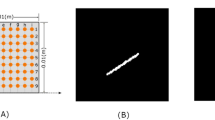Abstract
We present a discontinuity detector constructed by deep neural networks. Using convolutional neural network (CNN) structure, we design a comprehensive set of synthetic training data. The data consist of randomly generated piecewise smooth functions evaluated at equidistance grids, with labels denoting troubled cells where discontinuities are present. Upon successful training of the network, the CNN based detection network is capable of accurately identifying discontinuities in newly given function data by correctly labeling the troubled cells. Even though all of our training data have fixed size, the constructed detector can be applied to function data of arbitrary size, so long as they are on equidistance grids. To increase the detection efficiency in two- and three-dimensional cases, we propose a two-level detection procedure, where the detector is applied to a coarsened grid first and then to the fine grids only at the troubled cells identified at the coarse level. Through an extensive set of numerical tests, we demonstrate that the developed detectors possess strong generalization capabilities, in the sense that they are able to accurately detect discontinuity with structures much more complex than those in the training data.













Similar content being viewed by others
Data availability
Enquiries about data availability should be directed to the authors.
Notes
For the CNN above, \(\mathcal {N}(\tilde{v}_{f})=\text{ FC }\circ \text{ conv5 }\circ \text{ conv4 }\circ \text{ conv3 }\circ \text{ conv2 }\circ \text{ conv1 }(\tilde{v}_{f})\), where conv1, conv2, conv3, conv4, conv5 are the functions of the five convolutional layers and FC is the function of the fully connected layer. See the description of those functions in Sect. 2.2.
References
Archibald, R., Gelb, A., Yoon, J.: Polynomial fitting for edge detection in irregularly sampled signals and images. SIAM J. Numer. Anal. 43, 259–279 (2005)
Archibald, R., Gelb, A., Yoon, J.: Determining the locations and discontinuities in the derivatives of functions. Appl. Numer. Math. 58, 577–592 (2008)
Bozzini, M., De Tisi, F., Rossini, M.: Irregularity detection from noisy data with wavelets. In: Laurent, P.-J., Le Mehaute, A., Schumaker, L. (eds.) Wavelets, Images, and Surface Fitting, pp. 75–82. AK Peters/CRC Press (1994)
El-Sayed, M., Estaitia, Y.A., Khafagy, M.A.: Automated edge detection using convolutional neural network. Int. J. Adv. Comput. Sci. Appl. 4, 11–17 (2013)
Gao, Z., Wen, X., Don, W.S.: Enhanced robustness of the hybrid compact-WENO finite difference scheme for hyperbolic conservation laws with multi-resolution analysis and Tukey’s boxplot method. J. Sci. Comput. 73, 736–752 (2017)
Goodfellow, I., Bengio, Y., Courville, A.: Deep Learning. MIT Press (2016). http://www.deeplearningbook.org
Jain, R., Kasturi, R., Schunck, B.G.: Machine Vision, vol. 5. McGraw-Hill, New York (1995)
Kingma, D.P., Ba, J.: Adam: A Method for Stochastic Optimization. arXiv preprint arXiv:1412.6980 (2014)
Krizhevsky, A., Sutskever, I., Hinton, G.E.: Imagenet classification with deep convolutional neural networks. In: Advances in Neural Information Processing Systems, pp. 1097–1105 (2012)
Lavin, A., Gray, S.: Fast algorithms for convolutional neural networks. IEEE Conf. Comput. Vis. Pattern Recognit. 1, 4013–4021 (2016)
LeCun, Y., Boser, B., Denker, J.S., Henderson, D., Howard, R.E., Hubbard, W., Jackel, L.D.: Backpropagation applied to handwritten zip code recognition. Neural Comput. 1, 541–551 (1989)
Liu, Y., Cheng, M.-M., Hu, X., Bian, J.-W., Zhang, L., Bai, X., Tang, J.: Richer convolutional features for edge detection. IEEE Trans. Pattern Anal. Mach. Intell. 41, 1939–1946 (2019)
Suresh, V., Koteswarao Rao, S., Thiagarajan, G., Das, R.P.: Denoising and detecting discontinuities using wavelets. Indian J. Sci. Technol. 9, 19 (2016)
Vuik, M.J., Ryan, J.K.: Automated parameters for troubled-cell indicators using outlier detection. SIAM J. Sci. Comput. 38, A84–A104 (2016)
Wang, R.: Edge detection using convolutional neural network. In: Advances in Neural Networks—ISNN, pp. 12–20. Springer, Cham (2016)
Wei, M., De Pierro, A.R., Yin, J.: Iterative methods based on polynomial interpolation filters to detect discontinuities and recover point values from Fourier data. IEEE Trans. Signal Process. 53, 136–146 (2004)
Wen, C., Liu, P., Ma, W., Jian, Z., Lv, C., Hong, J., Shi, X.: Edge detection with feature re-extraction deep convolutional neural network. J. Vis. Commun. Image Represent. 57, 84–90 (2018)
Xue, C., Zhang, J., Xing, J., Lei, Y., Sun, Y.: Research on edge detection operator of a convolutional neural network. In: IEEE 8th Joint International Information Technology and Artificial Intelligence Conference, pp. 49–53 (2019)
Zhang, G., Webster, C.G., Gunzburger, M., Burkardt, J.: Hyperspherical sparse approximation techniques for high-dimensional discontinuity detection. SIAM Rev. 58, 517–551 (2016)
Funding
This work was partially supported by AFOSR FA9550-18-1-0102.
Author information
Authors and Affiliations
Corresponding author
Ethics declarations
Conflict of interest
The authors have not disclosed any competing interests.
Additional information
Publisher's Note
Springer Nature remains neutral with regard to jurisdictional claims in published maps and institutional affiliations.
Rights and permissions
About this article
Cite this article
Wang, S., Zhou, Z., Chang, LB. et al. Construction of discontinuity detectors using convolutional neural networks. J Sci Comput 91, 40 (2022). https://doi.org/10.1007/s10915-022-01804-z
Received:
Revised:
Accepted:
Published:
DOI: https://doi.org/10.1007/s10915-022-01804-z




